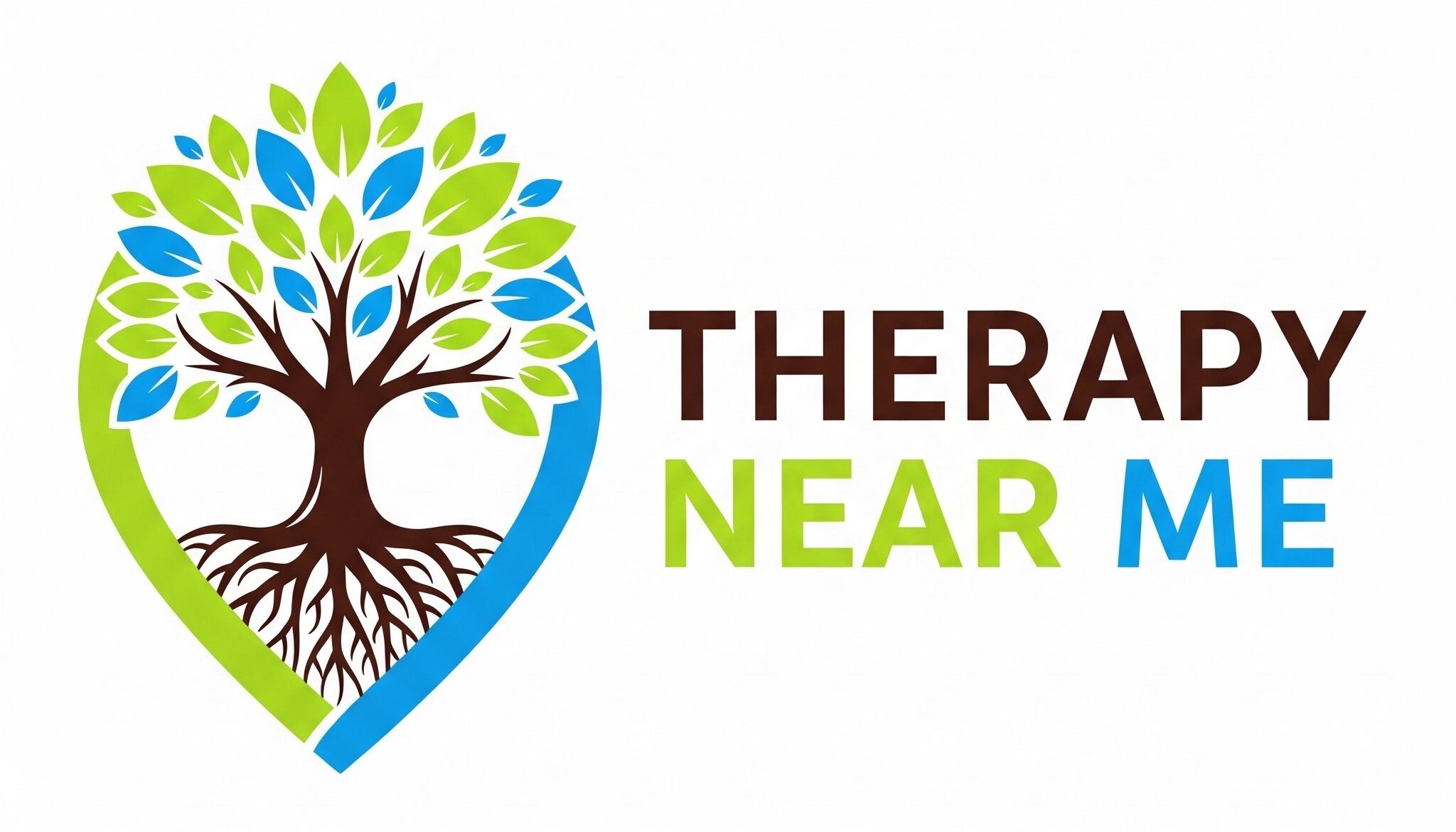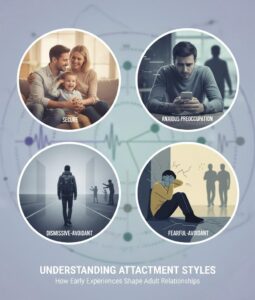Introduction
Attachment theory, first developed by John Bowlby (1969) and expanded by Mary Ainsworth (1978), explains how early relationships with caregivers shape emotional and social development. Attachment patterns influence how people regulate emotions, manage stress, and form close relationships across the lifespan. Understanding attachment types is essential in both clinical psychology and everyday life, as insecure attachment has been linked to anxiety, depression, personality disorders, and relational difficulties (Mikulincer & Shaver, 2016).
This article reviews the four main attachment types—secure, anxious, avoidant, and disorganised—their origins, impact on mental health, and implications for therapy and parenting.
1. Secure attachment
Characteristics
- Comfort with closeness and autonomy.
- Trust in others’ availability and reliability.
- Effective emotional regulation and resilience under stress.
Origins
Secure attachment develops when caregivers are consistently responsive, attuned, and supportive of a child’s needs (Ainsworth et al., 1978).
Outcomes
Adults with secure attachment show healthier romantic and family relationships, greater empathy, and reduced risk of mental illness (Feeney & Noller, 1996).
2. Anxious (ambivalent) attachment
Characteristics
- Preoccupation with relationships.
- Fear of abandonment and rejection.
- Emotional intensity and hypervigilance to relational cues.
Origins
Often arises from inconsistent caregiving, where parents are sometimes available but other times intrusive or neglectful (Cassidy & Berlin, 1994).
Outcomes
Anxious attachment is linked to higher risk of depression, anxiety, and borderline personality disorder (Mikulincer & Shaver, 2016).
3. Avoidant attachment
Characteristics
- Preference for emotional distance.
- Suppression of attachment needs.
- Discomfort with intimacy and dependence.
Origins
Avoidant attachment develops when caregivers are emotionally unavailable, dismissive, or rejecting, teaching children to downregulate emotional expression (Main et al., 1985).
Outcomes
Associated with difficulties in emotional intimacy, workaholism, and vulnerability to stress-related disorders (Dozier & Kobak, 1992).
4. Disorganised attachment
Characteristics
- Conflicted approach: seeking closeness while fearing it.
- Chaotic, unpredictable relational patterns.
- Heightened risk of dissociation and emotional dysregulation.
Origins
Disorganised attachment often emerges in contexts of abuse, neglect, or caregiver fearfulness, where the caregiver is simultaneously a source of comfort and threat (Lyons-Ruth & Jacobvitz, 2008).
Outcomes
Disorganised attachment strongly predicts complex PTSD, borderline personality disorder, and relational instability (van IJzendoorn & Bakermans-Kranenburg, 1996).
5. Adult attachment and relationships
While attachment styles form in childhood, they are not fixed. Adult relationships, therapy, and self-reflection can promote greater security. For example:
- Romantic relationships: Insecurely attached adults may engage in cycles of clinginess, withdrawal, or conflict. Secure attachment supports mutual trust and satisfaction (Hazan & Shaver, 1987).
- Parenting: Parents with secure attachment are more likely to foster secure bonds in their children, though interventions can support insecure parents (van IJzendoorn, 1995).
- Therapy: The therapeutic relationship itself can serve as a corrective attachment experience (Mallinckrodt, 2010).
6. Clinical and therapeutic implications
- Assessment: Tools such as the Adult Attachment Interview (AAI) and Experiences in Close Relationships (ECR)scale help identify patterns.
- Treatment approaches: Attachment-focused therapy, mentalization-based treatment (MBT), and emotionally focused therapy (EFT) target relational dynamics.
- Psychoeducation: Teaching clients about attachment normalises experiences and builds motivation for change.
Conclusion
Attachment types are foundational to mental health and relational wellbeing. While insecure attachment increases vulnerability to psychological difficulties, secure attachment fosters resilience and positive outcomes. Through therapy, supportive relationships, and intentional parenting, attachment security can be strengthened across the lifespan.
FAQs
Q: What are the 4 types of attachment?
Secure, anxious (ambivalent), avoidant, and disorganised.
Q: Can attachment styles change over time?
Yes. Through therapy, relationships, and personal growth, insecure styles can shift toward greater security.
Q: How does insecure attachment affect mental health?
It increases risk for depression, anxiety, PTSD, and relational difficulties.
Q: What is the most common attachment style?
Secure attachment is the most common, occurring in around 60–65% of children in normative populations (van IJzendoorn & Kroonenberg, 1988).
References
- Ainsworth, M.D.S., Blehar, M.C., Waters, E. & Wall, S. (1978) Patterns of attachment: A psychological study of the strange situation. Hillsdale, NJ: Erlbaum.
- Bandura, A. (1997) Self-efficacy: The exercise of control. New York: Freeman.
- Bowlby, J. (1969) Attachment and loss: Vol. 1. Attachment. New York: Basic Books.
- Cassidy, J. & Berlin, L.J. (1994) ‘The insecure/ambivalent pattern of attachment: Theory and research’, Child Development, 65(4), pp. 971–981.
- Dozier, M. & Kobak, R.R. (1992) ‘Psychophysiology in attachment interviews: Converging evidence for deactivating strategies’, Child Development, 63(6), pp. 1473–1480.
- Feeney, J.A. & Noller, P. (1996) Adult attachment. London: Sage.
- Hazan, C. & Shaver, P. (1987) ‘Romantic love conceptualised as an attachment process’, Journal of Personality and Social Psychology, 52(3), pp. 511–524.
- Lyons-Ruth, K. & Jacobvitz, D. (2008) ‘Attachment disorganisation: Genetic factors, parenting contexts, and developmental transformation from infancy to adulthood’, in Cassidy, J. & Shaver, P.R. (eds) Handbook of attachment: Theory, research, and clinical applications. 2nd edn. New York: Guilford Press, pp. 666–697.
- Mallinckrodt, B. (2010) ‘The psychotherapy relationship as attachment: Evidence and implications’, Journal of Social and Personal Relationships, 27(2), pp. 262–270.
- Mikulincer, M. & Shaver, P.R. (2016) Attachment in adulthood: Structure, dynamics, and change. 2nd edn. New York: Guilford Press.
- Main, M., Kaplan, N. & Cassidy, J. (1985) ‘Security in infancy, childhood, and adulthood: A move to the level of representation’, Monographs of the Society for Research in Child Development, 50(1–2), pp. 66–104.
- Paquette, D. (2004) ‘Theorizing the father–child relationship: Mechanisms and developmental outcomes’, Human Development, 47(4), pp. 193–219.
- van IJzendoorn, M.H. (1995) ‘Adult attachment representations, parental responsiveness, and infant attachment: A meta-analysis on the predictive validity of the Adult Attachment Interview’, Psychological Bulletin, 117(3), pp. 387–403.
- van IJzendoorn, M.H. & Bakermans-Kranenburg, M.J. (1996) ‘Attachment disorders and disorganized attachment: Research and clinical perspectives’, Journal of the American Academy of Child & Adolescent Psychiatry, 35(6), pp. 776–786.
- van IJzendoorn, M.H. & Kroonenberg, P.M. (1988) ‘Cross-cultural patterns of attachment: A meta-analysis of the strange situation’, Child Development, 59(1), pp. 147–156.







